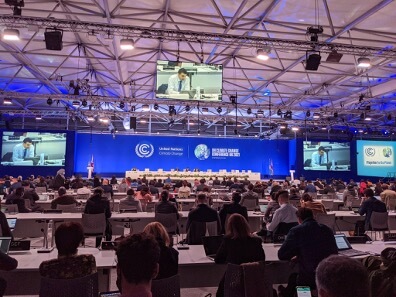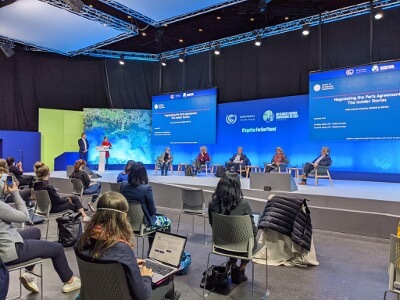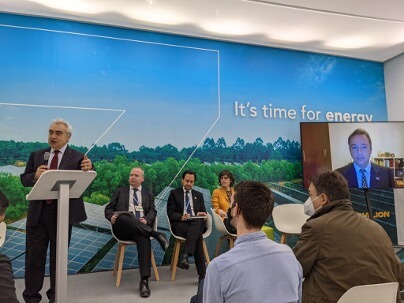The United Nations Climate Change conference has been held every year since 1995. At the Conference of the Parties (COP), organized by the UNFCCC, parties come together to discuss solutions for combating climate change. Due to the COVID-19 pandemic, COP26 was delayed one year. The pandemic and all that has come along with it makes this event different from other annual COPs. Alongside this backdrop, we can see how crucial this even is, with many goals that have to be achieved in COP26. In terms of the number of participants, it’s the biggest COP to date. Politicians, businesspeople, scientists, and representatives from various NGOs gather in Glasgow to make progress on climate negotiations.
Various Events at COP26
The COP conference is divided into Blue Zone and Green Zone. While the Blue Zone is only accessible for accredited participants, the Green Zone is open to the public. Within the Blue Zone, several negotiations and side events are taking place. They’re designated into either open or closed meetings. The closed meetings are not open to the observers, but this group can participate in open meetings with the compliance of the Covid-19 Code of Conduct. On the 1st and 2nd of November, UNFCCC launched a ticket system for NGO badge holders in light of the capacity limit in different negotiation rooms. The ticket collection process was very chaotic and confusing in the beginning, given that no one had experience with this pandemic-specific rule before and the organizers did not communicate instructions adequately. The ticket system was lifted after the World Leaders Summit; however, every negotiation room allows only for one representative from nine different NGO constituencies. The University of Bayreuth belongs to RINGO (Research and Independent NGOs), and it is highly recommended to attend the RINGO coordination meetings every morning for scheduling, as well as added information for any special events that take place and need to adopt the ticket system again.
Apart from the negotiation and consultation for the technical details in the Agreements, there is a broad range of events organized by the UNFCCC secretariat and different pavilions. Some parties and organizations have their own pavilion, while some share with others. The pavilions provide a space for networking, experience sharing, panel discussions, and open dialogue between participants and experts. It’s very interesting to wander around different pavilions and see various projects and initiatives coming from the bottom-up. However, it’s worth bearing in mind that some of the host organizations are trying to promote certain ideas, so the messages that they deliver can be quite one-sided. On the other hand, the official side events from UNFCCC include different voices from various groups. It was more interesting for us to attend different side events and listen to both affirmative and negative sides.



Achievements in the first week
COP26 was kick-started by the World Leaders Summit on Monday. After the first week of negotiations, four main commitments were made in COP26:
- 134 countries, covering 91% of the world’s forests, agreed to halt deforestation and land degradation by 2030.
- 103 countries signed up for the Global Methane Pledge to cut 30% of methane emissions by 2030.
- 40 countries have signed up for the Glasgow Breakthroughs, aiming to make green technologies affordable, accessible, and attractive globally by 2030. It focuses on five polluted sectors, including power, road transport, steel, hydrogen, and agriculture.
- Over 450 of the world’s largest banks, insurance companies, pension funds, and many more finance-related institutions have committed to the Glasgow Financial Alliance for Net Zero (GFANZ). Signatories have committed to reporting on the annual carbon emissions related to their investments. The alliance does not include requirements to divest from fossil fuels, for example. In total, a sum of $ 130 trillion is covered under GFANZ, an equivalent of 40% of global GDP.
In addition to that, individual countries also ramped up their ambitions and made new commitments to curb carbon emission and mobilize climate finance. For example, India’s prime minister Narendra Modi pledged to net zero by 2070. Additionally, new commitments came from the United Kingdom, Spain, Japan, Australia, Norway, Ireland, and Luxembourg related to climate finance, contributing to closing the gap and probably delivering the promised $100 billion to developing countries every year by 2023.
Making progress but still not enough
We are witnessing progress at COP26. The International Energy Agency (IEA) predicted that temperature will rise 1.8 degrees if all the updated targets and pledges on the table are met. Before COP26, the climate action tracker projected that we are on a warming trajectory of 2.7 ℃. From 2.7 ℃ to 1.8 ℃ is great progress, but it’s still not enough. The latest IPCC report clearly stated anthropogenic greenhouse gas emissions have largely changed the climate system and are directly linked to extreme weather hazards. Each additional degree of warming will no doubt increase and magnify natural disasters and might induce some devasting compound extreme events. It’s the code red for humanity. For many geographically vulnerable and least economically developed countries, 1.5 ℃ does not represent a choice but a right to survival.
Moreover, most climate finance flows into projects that reduce carbon emissions instead of helping people adapt to the new climate. Adaptation accounts for less than 10 % of the global landscape of climate finance. Wealthy countries favor mitigation projects because success is easier and measurable. Another reason is that mitigation projects can be loan-based and the return is foreseen. If the world leaders can’t fix the disproportionate difference between mitigation and adaptation, it’s clear that climate justice still takes a distant back seat. Another uncertainty we must keep in mind is how the leaders bring their commitments back home and implement them in policies and laws. How to keep countries accountable would rely on the various mechanisms in the Paris Agreement, such as the ratchet mechanism and global stocktake. Much more technical details must be discussed in the second week. Thus, we should not be satisfied with the current outcomes. The more we get comfort from our achievement, the closer we get to failure.












COP26 is very very important for the Globe to combat climate change. So the achievement of COP26 is needed to implement.
thank you